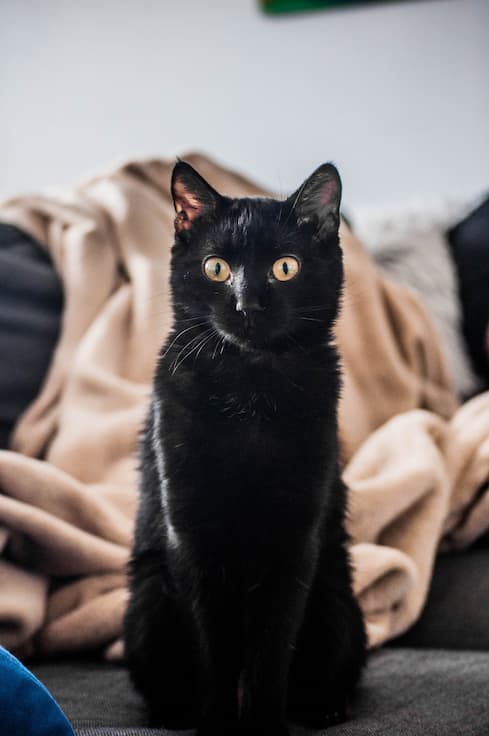Milk for the Cat
Milk for the cat is a poem written by the popular English poet Harold Monro. The poem is a light-hearted description of the amusing actions of a black cat. All you need to know and learn about this chapter is given below.
Meet the Author
- Harold Monro is an English war poet who helped other poets to publish and popularize their works.
- Born: 14 March 1879
- Place of Birth: Brussel, Belgium (Later lived in London)
- Died: 16 March 1932
- Major Books: 'Children of Dawn', ‘Real Property’ and 'Strange Meetings'
- Best known for: Harold Monro was famous for his contributions to Great War poetry. He was also the founder of a Poetry Bookshop at Bloomsbury, London. He ran a periodical titled “Poetry and Drama”. His bookshop was a hub for other poets including TS Eliot during those times.

Summary of the Poem
Harold Monro's poem Milk for the Cat is a simple, humorous account about the activities of a black domestic cat and how it interacts with her surroundings.
The little black cat with bright green eyes,
Is suddenly purring there.”
Poet explains the setting of the house in the first stanza. The curtains are drawn neatly and the little black cat who has bright green eyes is seen suddenly purring. It is understood from the stanza that the cat is aware of the tea break that occurs daily at 5 o'clock.
She catches the occupants of the house off guard as she's seen suddenly appearing in the house. The poet then confirms that she is never late. She acts calm when the tea is being served even though she is anticipating her milk in silence. Finally when the milk is brought into the room her casual glance suddenly turns into an attentive and stiff gaze.
And presently her agate eyes
Take a soft large milky haze,
And her independent casual glance
Becomes a stiff, hard gaze.
Then the poet goes on to elaborate the relation between the cat and milk. She is preparing herself before gulping down the milk. She slowly stretches her body and stamps her claws and twists her tail. Soon her body becomes a 'single breathing trembling purr'.The room consists of laughing children and two old ladies. She is not concerned with their presence. Her only focus is on the milk.
The poet tends to use the literary device called ‘hyperbole’ (further explanation provided in the Bonus Info section below) to explain the moments. The white saucer in which the milk is brought in is compared to the bright full moon descending from the cloudy night sky. Soon the interaction between cat and the milk is compared to that of the reunion of two lovers.
She sighs and dreams and thrills glows,
Transfigured with love.
The poet compares the cat and milk to long separated lovers. The cat is seen to immerse herself into the creamy sea of milk. She tends to forget her surroundings in the course of her consumption. She drinks up to the last holy drop of milk. She is seen to have been losing herself into the infinite shapeless white color of the milk. According to the poet, this is indicative of true love and passion between them.
She is in extreme happiness as she is drinking up the last holy drop before she gets back into the night. The process of having this milk is compared to her having her dreams come true. She is thrilled and glows with love in the process.
A long, dim ecstasy holds her life,
Her world is an infinite shapeless white,
Till her tongue has curled the last drop,
Then she sinks back into the night.
After having her milk she is seen to be lying defeated and tired in the great armchair. She soon fell asleep. She sleeps for three to four hours and is undisturbed by anything.
The poet brings in the element of humor while he describes the antics of the house cat. He is narrating the simple and mundane act of drinking milk to the reunion of lovers. While this is an amusing sight for humans this happiness might be a reality for the cat.
Share Options
Bonus Info
Hyperbole:
Hyperbole is an exaggeration of a normal situation or thing. They are not meant to be understood literally.
In the poem the poet is comparing the white sauce of milk to a bright full moon descending from a cloudy night sky. In this comparison the author is using the literary device called hyperbole. Here, he is exaggerating a common element. It is a normal saucer containing milk but he turns it into a larger than life image to enhance the poem.
Hyperbole is used to enhance the effect in the poem. This rhetorical device can be used to convey a humorous and a sensitive issue/character.
Cat Reference in Poems:
Poets from all generations are seen to be obsessed with cats. This is not the first poem written based on a cat. Other such poems include,
- February by Margaret Atwood
- Naming of Cats by TS Eliot.
- The cat and the Moon by WB Yeat
Great War Poetry:
World war 1 was a profound time in history for poets. A lot of creative work pertaining to the war and its tragedy happened during this period. Harold Monroe has significantly contributed to the development of Great War poetry.
These poems illustrated the tragic lives of soldiers, women and children during the war. It also underlined the unwanted blood sheet and the aftermath of the war. These poems do give insights into life during war.
Other major war poets include Wilfred Oven, Siegfreed Sasson and Carol Ann Duffy.
Share Options
Get Personalized Tuitions
We offer premium education on a personalized level. Online tuition for all grades, tailor-made!

Milk for the Cat Questions and Answers
Below are a few questions that you can look out for your examinations and class tests. Stand out with perfectly written answers with help of Aneetta Class.
Tea is served for the occupants of the house and milk is offered to the cat at five o'clock.
She curls up on the armchair for a three to four hour sleep.
It means the increasing desire for milk shown by the cat.